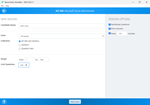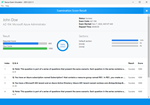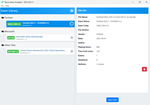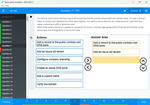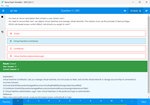Download VMware Cloud Foundation Specialist (v2).5V0-31.VCEplus.2025-04-02.61q.tqb
| Vendor: | VMware |
| Exam Code: | 5V0-31 |
| Exam Name: | VMware Cloud Foundation Specialist (v2) |
| Date: | Apr 02, 2025 |
| File Size: | 311 KB |
How to open TQB files?
Files with TQB (Taurus Question Bank) extension can be opened by Taurus Exam Studio.
Purchase
Coupon: TAURUSSIM_20OFF
Discount: 20%
Demo Questions
Question 1
What are the correct steps to grant the DevOps team permissions to a vSphere Namespace in a VMware Cloud Foundation (VCF) developer-ready workload domain while following the principle of least privilege access?
- At the Permissions setting, add the DevOps group and assign the ''Editor'' permission
- At the Global Permissions setting, add the DevOps group and assign the vSphere Kubernetes Manager role
- At the Global Permissions setting, add the DevOps group and assign the SupervisorService Cluster Operator role
- At the Permissions setting, add the DevOps group and assign the ''Can edit'' permission
Correct answer: A
Explanation:
At the Permissions setting, add the DevOps group and assign the ''Editor'' permission. This is the recommended way to grant the DevOps team permissions to a vSphere Namespace in a VMware Cloud Foundation (VCF) developer-ready workload domain while following the principle of least privilege access.According to the VMware Cloud Foundation documentation1, the Editor permission allows users to create, modify, and delete objects within a vSphere Namespace, such as vSphere Pods, Tanzu Kubernetes clusters, and stand-alone VMs.The Editor permission also allows users to view and manage storage policies, VM classes, and content libraries for the namespace1B) At the Global Permissions setting, add the DevOps group and assign the vSphere Kubernetes Manager role is not a correct option, because it will grant more privileges than necessary to the DevOps team. The vSphere Kubernetes Manager role is a global role that allows users to manage all aspects of vSphere with Tanzu, such as enabling Workload Management on clusters, creating and configuring vSphere Namespaces, and managing storage policies and VM classes.This role should be assigned only to vSphere administrators who are responsible for configuring and maintaining the VCF developer-ready workload domain1 C) At the Global Permissions setting, add the DevOps group and assign the SupervisorService Cluster Operator role is not a correct option, because it will also grant more privileges than necessary to the DevOps team. The SupervisorService Cluster Operator role is a global role that allows users to manage all aspects of Supervisor Services on clusters, such as creating and configuring Supervisor Service namespaces, managing service accounts and roles, and deploying service instances.This role should be assigned only to vSphere administrators who are responsible for enabling and managing Supervisor Services on VCF developer-ready workload domains1 D) At the Permissions setting, add the DevOps group and assign the ''Can edit'' permission is not a correct option, because there is no such permission in vSphere with Tanzu. The available permissions for vSphere Namespaces are Viewer, Editor, and Admin. The Viewer permission allows users to view objects within a vSphere Namespace, but not create or modify them.The Admin permission allows users to perform all actions within a vSphere Namespace, as well as manage permissions for other users or groups1 At the Permissions setting, add the DevOps group and assign the ''Editor'' permission. This is the recommended way to grant the DevOps team permissions to a vSphere Namespace in a VMware Cloud Foundation (VCF) developer-ready workload domain while following the principle of least privilege access.According to the VMware Cloud Foundation documentation1, the Editor permission allows users to create, modify, and delete objects within a vSphere Namespace, such as vSphere Pods, Tanzu Kubernetes clusters, and stand-alone VMs.The Editor permission also allows users to view and manage storage policies, VM classes, and content libraries for the namespace1
B) At the Global Permissions setting, add the DevOps group and assign the vSphere Kubernetes Manager role is not a correct option, because it will grant more privileges than necessary to the DevOps team. The vSphere Kubernetes Manager role is a global role that allows users to manage all aspects of vSphere with Tanzu, such as enabling Workload Management on clusters, creating and configuring vSphere Namespaces, and managing storage policies and VM classes.This role should be assigned only to vSphere administrators who are responsible for configuring and maintaining the VCF developer-ready workload domain1
C) At the Global Permissions setting, add the DevOps group and assign the SupervisorService Cluster Operator role is not a correct option, because it will also grant more privileges than necessary to the DevOps team. The SupervisorService Cluster Operator role is a global role that allows users to manage all aspects of Supervisor Services on clusters, such as creating and configuring Supervisor Service namespaces, managing service accounts and roles, and deploying service instances.This role should be assigned only to vSphere administrators who are responsible for enabling and managing Supervisor Services on VCF developer-ready workload domains1 D) At the Permissions setting, add the DevOps group and assign the ''Can edit'' permission is not a correct option, because there is no such permission in vSphere with Tanzu. The available permissions for vSphere Namespaces are Viewer, Editor, and Admin. The Viewer permission allows users to view objects within a vSphere Namespace, but not create or modify them.The Admin permission allows users to perform all actions within a vSphere Namespace, as well as manage permissions for other users or groups1
Question 2
Which statement accurately describes a Tanzu Spherelet?
- A Spherelet runs as a VM on the supervisor cluster.
- The Spherelet runs as an agent on the vCenter server of the Tanzu-enabled VCF workload domain.
- A Spherelet upgrade does not have any impact on the PODs running on the supervisor cluster node.
- The Spherelet communicates with the control plane's API server.
Correct answer: D
Explanation:
https://docs.vmware.com/en/VMware-vSphere/8.0/vsphere-with-tanzu-concepts-planning/GUID-3E4E6039-BD24-4C40-8575-5AA0EECBBBEC.htmlSpherelet. An additional process called Spherelet is created on each host. It is a kubelet that is ported natively to ESXi and allows the ESXi host to become part of the Kubernetes cluster. https://docs.vmware.com/en/VMware-vSphere/8.0/vsphere-with-tanzu-concepts-planning/GUID-3E4E6039-BD24-4C40-8575-5AA0EECBBBEC.html
Spherelet. An additional process called Spherelet is created on each host. It is a kubelet that is ported natively to ESXi and allows the ESXi host to become part of the Kubernetes cluster.
Question 3
What do VM Storage Policies match to when using vSphere with Tanzu?
- Kubernetes storage classes in the Supervisor Cluster
- Kubernetes datastores in a namespace
- Kubernetes storage classes in a namespace
- Kubernetes datastores in the Supervisor Cluster
Correct answer: C
Explanation:
https://docs.vmware.com/en/VMware-vSphere/8.0/vsphere-with-tanzu-installation-configuration/GUID-544286A2-A403-4CA5-9C73-8EFF261545E7.htmlAfter creating storage policies, a vSphere administrator can perform the following tasks: Assign the storage policies to the Supervisor. The storage policies configured on the Supervisor ensure that the control plane VMs, pod ephemeral disks, and container images are placed on the datastores that the policies represent. Assign the storage policies to the vSphere Namespace. Storage policies visible to the namespace determine which datastores the namespace can access and use for persistent volumes. The storage policies appear as matching Kubernetes storage classes in the namespace. They are also propagated to the Tanzu Kubernetes cluster on this namespace.DevOps engineers can use the storage classes in their persistent volume claim specifications.The storage policies appear as matching Kubernetes storage classes in the namespace. They are also propagated to the Tanzu Kubernetes cluster on this namespace. DevOps engineers can use the storage classes in their persistent volume claim specifications https://docs.vmware.com/en/VMware-vSphere/8.0/vsphere-with-tanzu-installation-configuration/GUID-544286A2-A403-4CA5-9C73-8EFF261545E7.html https://docs.vmware.com/en/VMware-vSphere/8.0/vsphere-with-tanzu-installation-configuration/GUID-544286A2-A403-4CA5-9C73-8EFF261545E7.html
After creating storage policies, a vSphere administrator can perform the following tasks: Assign the storage policies to the Supervisor. The storage policies configured on the Supervisor ensure that the control plane VMs, pod ephemeral disks, and container images are placed on the datastores that the policies represent. Assign the storage policies to the vSphere Namespace. Storage policies visible to the namespace determine which datastores the namespace can access and use for persistent volumes. The storage policies appear as matching Kubernetes storage classes in the namespace. They are also propagated to the Tanzu Kubernetes cluster on this namespace.
DevOps engineers can use the storage classes in their persistent volume claim specifications.
The storage policies appear as matching Kubernetes storage classes in the namespace. They are also propagated to the Tanzu Kubernetes cluster on this namespace. DevOps engineers can use the storage classes in their persistent volume claim specifications
https://docs.vmware.com/en/VMware-vSphere/8.0/vsphere-with-tanzu-installation-configuration/GUID-544286A2-A403-4CA5-9C73-8EFF261545E7.html
Question 4
What is the correct sequence of steps to add a new VI Workload Domain in a VMware Cloud Foundation environment?
- 1. Configure DNS.2. Create a network pool.3. Commission hosts.4. Add licenses to SDDC Manager.5. Create the workload domain.
- 1. Configure DNS.2. Commission hosts.3. Create a network pool.4. Add licenses to SDDC Manager.5. Create the workload domain.
- 1. Create a network pool.2. Commission hosts.3. Add licenses to SDDC Manager.4. Create the workload domain.
- 1. Create a network pool.2. Commission hosts.3. Create the workload domain.4. Add licenses to SDDC Manager.
Correct answer: A
Question 5
Which two switches can be used to perform log collection using the SoS tool? (Choose two.)
- --psc-logs
- --vcenter-logs
- --nsxt-logs
- --wcp-logs
- --sddc-logs
Correct answer: AD
Explanation:
https://docs.vmware.com/en/VMware-Cloud-Foundation/4.5/vcf-admin/GUID-77C40307-8466-4331-A510-9334C0F6CF32.html https://docs.vmware.com/en/VMware-Cloud-Foundation/4.5/vcf-admin/GUID-77C40307-8466-4331-A510-9334C0F6CF32.html
Question 6
During a design workshop, an architect discussed strategies to backup and restore the SDDC Manager in a VMware Cloud Foundation environment. The customer asks for more clarification about the functionality and need for an external SFTP server.
Which two statements should the administrator share with the customer? (Choose two.)
- It stores backup for vSAN encryption keys.
- It provides better protection and decouples NSX-T backup from the SDDC Manager.
- It is a prerequisite for restoring Cloud Builder file-based backups.
- It is a prerequisite for restoring SDDC Manager file-based backups.
- It stores backup for vRealize Suite Lifecycle Manager.
Correct answer: BD
Explanation:
According to the VMware Cloud Foundation documentation1, an external SFTP server is recommended for storing backups of SDDC Manager and NSX-T Manager for the following reasons:It provides better protection against failures because it decouples NSX-T backups from SDDC Manager.It is a prerequisite for restoring SDDC Manager file-based backups.Therefore, statements B and D are correct and should be shared with the customer.1:Backup and Restore of VMware Cloud Foundationhttps://docs.vmware.com/en/VMware-Cloud-Foundation/5.0/vcf-admin/GUID-F8634D37-FA26-40DF-A135-62D0265DA4FA.htmlBy default, NSX Manager file-based backups are taken and stored on an SFTP server that is built into the SDDC Manager appliance. It is recommended that you configure an external SFTP server as a backup location for the following reasons: An external SFTP server is a prerequisite for restoring SDDC Manager file-based backups. Using an external SFTP server provides better protection against failures because it decouples NSX backups from SDDC Manager. According to the VMware Cloud Foundation documentation1, an external SFTP server is recommended for storing backups of SDDC Manager and NSX-T Manager for the following reasons:
- It provides better protection against failures because it decouples NSX-T backups from SDDC Manager.
- It is a prerequisite for restoring SDDC Manager file-based backups.
Therefore, statements B and D are correct and should be shared with the customer.
1:Backup and Restore of VMware Cloud Foundation
https://docs.vmware.com/en/VMware-Cloud-Foundation/5.0/vcf-admin/GUID-F8634D37-FA26-40DF-A135-62D0265DA4FA.html
By default, NSX Manager file-based backups are taken and stored on an SFTP server that is built into the SDDC Manager appliance. It is recommended that you configure an external SFTP server as a backup location for the following reasons: An external SFTP server is a prerequisite for restoring SDDC Manager file-based backups. Using an external SFTP server provides better protection against failures because it decouples NSX backups from SDDC Manager.
Question 7
Which tool can be used to add a new vSphere Cluster to an existing VI Workload Domain?
- vSphere Client
- VMware Imaging Appliance
- SDDC Manager
- Cloud Builder
Correct answer: C
Explanation:
https://docs.vmware.com/en/VMware-Cloud-Foundation/4.5/vcf-admin/GUID-D3C55AA8-D4B9-49D4-A26F-7A713A141251.htmlSDDC Manager is the tool that can be used to add a new vSphere cluster to an existing VI workload domain. SDDC Manager provides a unified interface for managing the lifecycle of the VMware Cloud Foundation components, including creating and expanding workload domains.VMware Cloud Foundation Administration Guide, Expand a Workload Domain sectionVMware Cloud Foundation Specialist (v2), Objective 4.1: Given a scenario, identify the steps to add a new vSphere cluster to an existing VI workload domain. https://docs.vmware.com/en/VMware-Cloud-Foundation/4.5/vcf-admin/GUID-D3C55AA8-D4B9-49D4-A26F-7A713A141251.html
SDDC Manager is the tool that can be used to add a new vSphere cluster to an existing VI workload domain. SDDC Manager provides a unified interface for managing the lifecycle of the VMware Cloud Foundation components, including creating and expanding workload domains.
VMware Cloud Foundation Administration Guide, Expand a Workload Domain section
VMware Cloud Foundation Specialist (v2), Objective 4.1: Given a scenario, identify the steps to add a new vSphere cluster to an existing VI workload domain.
Question 8
An architect is designing networking for a developer-ready infrastructure on VMware Cloud Foundation.
Which use case would require the architect to consider a CIDR range larger than /27 for Egress?
- More than 30 services are required
- More than 30 pods are required
- More than 30 load balancers are required
- More than 30 namespaces are required
Correct answer: D
Explanation:
https://docs.vmware.com/en/VMware-vSphere/7.0/vmware-vsphere-with-tanzu/GUID-B1388E77-2EEC-41E2-8681-5AE549D50C77.html#:~:text=Only%20one%20egress%20IP%20address%20is%20assigned%20for%20each%20namespace%20in%20the%20Supervisor%20Cluster https://docs.vmware.com/en/VMware-vSphere/7.0/vmware-vsphere-with-tanzu/GUID-B1388E77-2EEC-41E2-8681-
5AE549D50C77.html#:~:text=Only%20one%20egress%20IP%20address%20is%20assigned%20for%20each%20namespace%20in%20the%20Supervisor%20Cluster
Question 9
Which two components are required when planning for stretched clusters in a VMware Cloud Foundation environment? (Choose two.)
- There must be separate Network Pools for each Availability Zone.
- A third site is required for a witness host.
- The host overlay network can use static IP addresses.
- Use shared vSphere vMotion, vSAN, and host overlay networks.
- The round-trip time (RTT) between sites must be 15 milliseconds.
Correct answer: AB
Explanation:
https://docs.vmware.com/en/VMware-Cloud-Foundation/4.5/vcf-admin/GUID-CDEEF4C6-7DFC-4EB5-B5F5-3C41230926F9.html https://docs.vmware.com/en/VMware-Cloud-Foundation/4.5/vcf-admin/GUID-CDEEF4C6-7DFC-4EB5-B5F5-3C41230926F9.html
Question 10
An administrator needs to upgrade the current VMware Cloud Foundation (VCF) environment from version 4.1 to 4.3, knowing that the environment does not have direct access to the internet. Which steps should be performed to download the online bundles?
- 1. Setup a proxy server.2. Define the credentials to access the proxy server.3. Allow bidirectional traffic on the firewall.
- 1. Setup a proxy server.2. Configure the proxy in SDDC Manager.3. Restart the LCM service.
- 1. Setup a proxy server.2. Define the credentials to access the proxy server.3. Configure the proxy server in vSphere Lifecycle Manager (vLCM).4. Restart vSphere Lifecycle Manager (vLCM).
- 1. Setup a proxy server.2. Define the credentials to access the proxy server.3. Allow bidirectional traffic on the firewall.4. Configure the proxy server in SDDC Manager.
Correct answer: B
Explanation:
https://docs.vmware.com/en/VMware-Cloud-Foundation/4.3/vcf-lifecycle/GUID-BB15EADE-DCD3-4D51-824E-124C9B364D20.html https://docs.vmware.com/en/VMware-Cloud-Foundation/4.3/vcf-lifecycle/GUID-BB15EADE-DCD3-4D51-824E-124C9B364D20.html
HOW TO OPEN VCE FILES
Use VCE Exam Simulator to open VCE files
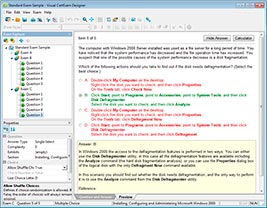
HOW TO OPEN VCEX FILES
Use ProfExam Simulator to open VCEX files
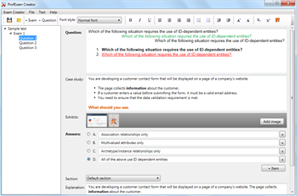
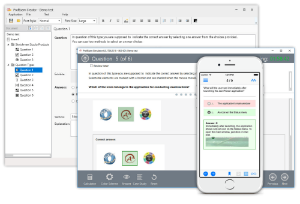
ProfExam at a 20% markdown
You have the opportunity to purchase ProfExam at a 20% reduced price
Get Now!